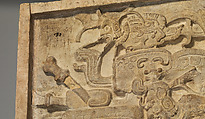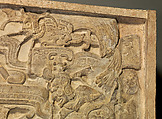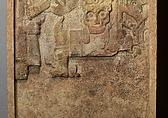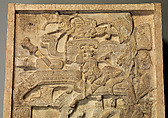On loan to The Met The Met accepts temporary loans of art both for short-term exhibitions and for long-term display in its galleries.
Portrait of a seated ruler receiving a noble (Stela 5)
On this intricately carved limestone stela, the ruler of Yok’ib (known today as Piedras Negras), K’inich Yo’nal Ahk II, sits on a throne and receives a noble visitor. He wears all the finery of an ancient Maya ajaw or ruler: a mosaic pectoral likely made of jade and other precious stones, bracelets and anklets also made of jade, and a headdress decorated with paper knots and water lilies and topped with a panache of quetzal feathers. A jaguar pelt covers the throne, with the feline’s head facing out towards the viewer in a rare example of frontal perspective. In one hand, Yo’nal Ahk II holds out a scepter, shaped in the profile of the deity K’awiil, a supernatural being associated with lightning and the authority of rulership. With this hand and the orientation of his body, he greets his visitor, a man named K’an Mo Te’, whose titles identify him as a baahteem sajal (a lower rank of nobility associated with royal audiences and visits).
Although this encounter between ruler and courtier might reflect a historical reality, the imagery accompanying this moment also places the scene within the mythological/fantastical realm. K’inich Yo’nal Ahk II’s throne sits within the fanged open mouth of a personified mountain, decorated with the triangular markings of snakeskin and grape-like clusters of circles indicating the stony nature of the mountain. Supernatural and animal beings emerge from crevices in the mountain’s stony surface. To the right behind the ruler’s head, a skeletal figure smoking a cigar (likely a personified firefly) reaches towards him. Just above this creature, an eroded figure resembling a monkey reclines, its tail curling towards where the ruler sits, and in the “eye socket” of the mountain’s face, a personification of the Jaguar God of the Underworld emerges. An avian deity known as the Principal Bird Deity perches on the mountain’s brow at the top of the composition, overseeing the scene below. By incorporating both historical and mythical elements into the scene, Maya artist-scribes implied the ruler’s divine influence over both the human and superhuman realms and illustrated the interwoven nature of the mundane and the mythical.
Commissioned by K’inich Yo’nal Ahk II and dedicated on November 2, 716 CE, Stela 5 originally formed part of a sequence of monuments set up in a line in front of the city’s palace complex. Carved by a group of royal sculptors, these monuments documented important events in the lives of the ruler and his immediate family. Glyphic texts that once appeared on the side of the monument provided its dedication date, as well as a record of the events depicted. Although most of its original pigment has faded away, Stela 5 would have been painted in vibrant red, accented with blue, white, or yellow, making the monument highly visible to people passing by in the plaza. Today, some of the red paint that would have covered most of the stela remains on the jaguar’s face and the throne below it. In addition to damage caused by the erosion of time, ancient iconoclasts also chipped away the ruler’s face in an attempt to diminish the monument’s power.
Initially documented in-situ in the 1890s by the explorer and archaeologist Teobert Maler, Stela 5 remained in its original location until the late 1950s or early 1960s. At this time, looters of ancient Maya art arrived at Piedras Negras and thinned the monument, cutting its width down to make it easier to transport the monument out of the site. In doing so, they destroyed the glyphic texts on the side of the monument and separated it from its base, which remains at the site and has been documented by the Peabody Museum of Archaeology and Ethnology (Stuart and Graham 2003, Figs. 9:32-35). The base depicts two upturned personified mountains below a platform decorated by leaves and crossed bones. Early photographs of the side texts (and line drawings created from them, also held by the Peabody Museum) now provide the only documentation of this lost historical record.
After its removal from Piedras Negras, Stela 5’s location remained unknown until its appearance on the New York art market in the early 1960s. The monument was purchased by the Museum of Primitive Art (MPA) in New York City in 1963. Shortly after the 1969 agreement to transfer the collections of the MPA to the Met, the Met entered into a long-term loan agreement with the Republic of Guatemala to allow Stela 5 to remain on view in the Michael C. Rockefeller Wing at the Met. With one piece of this monument in New York and the other at the site of Piedras Negras in Guatemala, Stela 5 exemplifies the legacy of a fraught and complicated history of looted objects and the need to work collaboratively to illuminate achievements of artists of the ancient world.
Catherine Nuckols, Sylvan C. Coleman and Pam Coleman Fellow in the History of Art and Visual Culture, 2025
Further Reading:
Luján Muñoz, Jorge. Dos estelas mayas sustraídas de Guatemala: Su presencia en Nueva York. Guatemala: Universidad de San Carlos de Guatemala, 1966.
Luján Muñoz, Jorge. “Acerca de la recuperación de varias esculturas mayas que salieron ilegalmente de Guatemala.” Mesoamérica, year 6, no. 10 (1985): 459-70.
Martin, Simon. Ancient Maya Politics: A Political Anthropology of the Classic Period 150-900 CE. Cambridge University Press, 2020, p. 86-87, 94.
Satterthwaite, Linton. Piedras Negras. Philadelphia, University Museum, University of Pennsylvania, 1935-54.
References:
Clancy, Flora S. The Monuments of Piedras Negras, an Ancient Maya City. Albuquerque: University of New Mexico Press, 2009, p. 93-99.
Coggins, Clemency Chase. “Illicit Traffic of Pre-Columbian Antiquities.” Art Journal, 29 no. 1 (1969): 96.
Coggins, Clemency Chase. “Displaced Mayan Sculpture.” Estudios De Cultura Maya, 8 (1970): 20.
Maler, Teobert. Researches in the Central Portion of the Usumatcintla Valley. Cambridge: Peabody Museum of American Archaeology and Ethnography, Harvard University, 1901, p. 48-49.
Martin, Simon and Nikolai Grube. Chronicle of the Maya Kings and Queens: Deciphering the Dynasties of the Ancient Maya. London: Thames & Hudson, 2008, p. 145-147.
O’Neil, Megan E. Engaging Ancient Maya Sculpture at Piedras Negras, Guatemala. Norman: University of Oklahoma Press, 2014, p. 201, 206.
Proskouriakoff, Tatiana. A Study of Classic Maya Sculpture. Washington, D. C., Carnegie Institution, 1950, p. 135.
Stuart, David and Ian Graham. Corpus of Maya Hieroglyphic Inscriptions Piedras Negras, Volume 9, Part 1. Cambridge, Massachusetts: Peabody Museum of Archaeology and Ethnology, Harvard University, 2003.
This image cannot be enlarged, viewed at full screen, or downloaded.
This artwork is meant to be viewed from right to left. Scroll left to view more.








